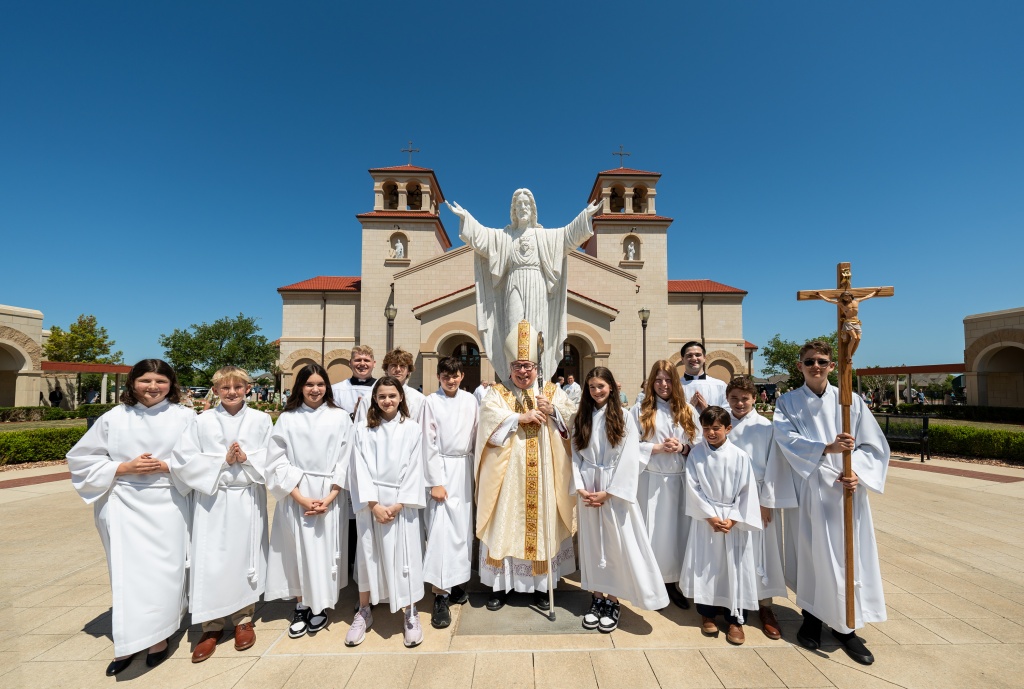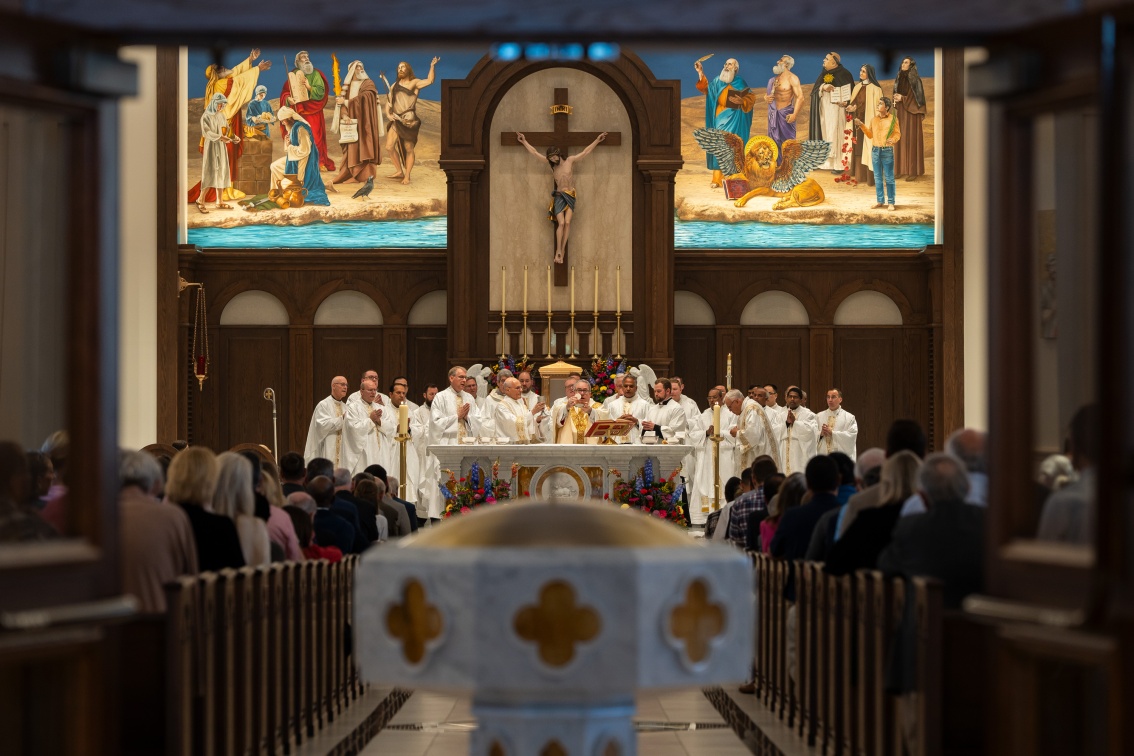Homily for the Mass of Dedication and Consecration of the Church of St. Mark
April 13, 2024
St. Mark Church
Argyle, Texas
Nehemiah 8:1-4a, 5-6, 8-10
Psalm 19b:8-9, 10-15
Revelation 21:1-5a
Matthew 16:13-20
Faith has brought us to this building, not simply our values. Faith tells us that Christ will transform this building to become a church. In our first reading from Nehemiah, we hear of how the Chosen People of the Old Covenant wept when hearing for the first time in seventy years the words of the Law as read by Ezra and Nehemiah. They wept for two reasons. First, they wept because during their time in captivity they had grown accustomed to a life lived without attention to the Covenant and their faith prompted them now to grieve for their sins. Secondly, they wept because of the beauty of the Covenant that had remained in their hearts where God had placed it and they again recognized it through faith in Him.
Our first reading indicates that the Chosen People went about the mission of rebuilding the Temple in accord with the Old Covenant. They did not simply build a building or a meeting place — the Lord established the Temple in preparation for sending His Son who would tear it down and rebuild it in three days, the Temple of His Body, born of the tender Virgin, the Temple consecrated to the Father, the Temple not made with human hands, the Temple of Christ’s Body, the Church, in which the fullness of the Godhead might dwell.
The parishioners of Saint Mark and their pastor, Father George Pullambrayil, the deacons, and staff, the laborers and architects, the diocesan officials, have built only a building — but it is Jesus Christ the cornerstone, who is the New and Eternal Covenant who builds His Church through the stones of those members fully initiated in communion with Him through Baptism, Confirmation, and Holy Eucharist. Today by God’s Grace alone given through our prayers and through the anointing with Chrism conducted in my obedient and apostolic ministry as your bishop, does this table become an altar and this building become a church.
The Gospel of this Liturgy presents to us the confession by Simon of Jesus to be not only a prophet, not only the Messiah, but truly the Son of God. Jesus has asked two questions of the assembled Apostles: “Who do people say that the Son of Man is?” and “But who do you say that I am?” It is Simon who has received the Grace to answer truthfully that Jesus is the Messiah, the Son of the living God. This is an answer that no one can deduce, especially Simon Peter, from the power of simple reason. As Jesus says, “Blessed are you, Simon, son of Jonah. For flesh and blood has not revealed this to you, but my heavenly Father.” This is a graced moment directly afforded by God out of His mercy. This graced moment is not only for Simon who received a new name and mission from Jesus that he become “Peter” the “rock.” The graced moment is for all the disciples of Jesus because it is here that they receive their identity and their mission as the Church — not just a community of disciples but the Church.
Simon’s confession marks the beginning of his life and pastoral responsibility as Peter. It marks the new life of the Church who accompanies Christ after His ministry in Galilee, and who now begins His journey and mission to Jerusalem where His Crucifixion and Resurrection await. Simon accompanies Jesus as Peter with stumbling along the way. He is Simon by birth, but he is called by Jesus to be Peter, the Rock, for the sake of Christ’s Church.
Like Peter, if we truly desire to live our identity as the members of the Church, we must accompany Jesus and be attentive to Him in our own lives as we follow Him towards Jerusalem for our share in the Crucifixion and Resurrection, even if we stumble along the way. Today, Jesus also asks us the same two questions that he asked the disciples in the Gospel: “Who do people say that the Son of Man is?” and “But who do you say that I am?” Jesus asks us to make a firm decision and to decide with Peter to be His Church or to remain outside as a bystander, only one of the crowd, who are spiritual but not religious.
Others thought that Jesus was a prophet. This is true but it is inadequate — for He is the Son of God. If we wish to stand with Peter and confess the truth of Jesus, we must not settle for a distant but comfortable perspective of merely knowing about Him or accepting His values as a bland spirituality. So many of the crowd today also have opinions about Jesus. To answer the question honestly like Peter we must also draw near to Christ, spend time with Him, be attentive to Him, do what He asks us to do, love Him and love others because He loves them; we must be willing to accept the grace of seeing His uniqueness which we can only do as a member of His One, Holy, Catholic and Apostolis Church, the Church which He established and for which He died when water and blood flowed from His side on Calvary.
The truth that we proclaim as the Church is not simply a set of values by which we agree to guide our lives as a group of like-minded individuals. The Truth that we proclaim is fully revealed in Christ and is beyond our natural capacity to deduce by reason alone. It is true that we can articulate the truth reasonably but only after it has been revealed and accepted by us through Grace that Jesus truly is the Son of the Living God. God reveals this to us in Christ through the transcendental of beauty.
Beauty is something that Christ uses to carry us to a point that is beyond our ability to grasp in this world. It is the beauty of Christ, small and powerless in a manger. It is the beauty of Christ at the Transfiguration. It is the beauty of Christ at the Resurrection where His glory transcends the earthly capacity for Mary Magdalene to grasp. It is even the beauty of Christ in the paradox of the Crucifixion.
This very beautiful building that displays integrity, proportionality, and luminous clarity, will receive a beauty in a few moments that only Christ can offer and that we, without Christ, can neither design nor produce. This beauty of the fullness of the Truth who is Jesus Christ. This beauty will attract us to our ultimate end of loving communion with the Holy Trinity and all the saints — more beautiful than any depiction of an afterlife that human thought can conjure or any image we can scroll on the screens of our phones.
This soon-to-be fully beautiful church of this parish will serve as a living symbol to a world that increasingly has wallowed in ugliness and imposes the cynical worldview that beauty is fantasy; that existential ugliness is what is real; there is no truth, only falsehood; and there is no God, only sin disguised as freedom. Yet, we know and are charged with proclaiming the Truth that this building will soon embody as a church, the eternal beauty of Christ as knowledge, a higher form of knowing, because it strikes us with the truth in all His greatness. Beauty is not knowledge through instruction. The beauty of Christ overcomes us as a more real, more profound knowledge than rational deduction. This is why, even more than apologetics, does our mission as Christ’s Church require us to present the beauty of Christ in our art, in our music, in our architecture, and most especially in our lives as lived for Christ and each other.
“I also saw the holy city, a new Jerusalem, coming down out of heaven from God, prepared as a bride adorned for her husband. I heard a loud voice from the throne saying, ‘Behold, God’s dwelling is with the human race. He will dwell with them, and they will be His people and God Himself will always be with them. He will wipe every tear from their eyes, and there shall be no more death or mourning, wailing or pain, for the old order has passed away.’ The one who sat on the throne said, ‘Behold, I make all things new.’”
As the fourteenth century theologian, Nichola Cabasilas explained, “When men have a longing so great that it surpasses human nature and eagerly desire and are able to accomplish things beyond human thought, it is the Bridegroom himself who has wounded them. Into their eyes He Himself has sent a ray of beauty. The size of the wound is evidenced by the arrow, and the longing points to the one who shot the arrow.” Or as Saint Augustine wrote more succinctly, “My heart is restless until it rests in you, Oh God.”
You, the Catholic Church in this parish with the patronal protection of Saint Mark, will stand with Peter and follow Christ to Jerusalem, as His Church who have received the Son of the Living God, the Church who invites by the beauty that adorns your Christian lives the cynical and indifferent to come and know the beauty of Christ, as His Church, “a chosen race, a royal priesthood, a holy nation, a people of his own, so that you may announce the praises” of Him who called you out of darkness into his wonderful light.”



You must be logged in to post a comment.